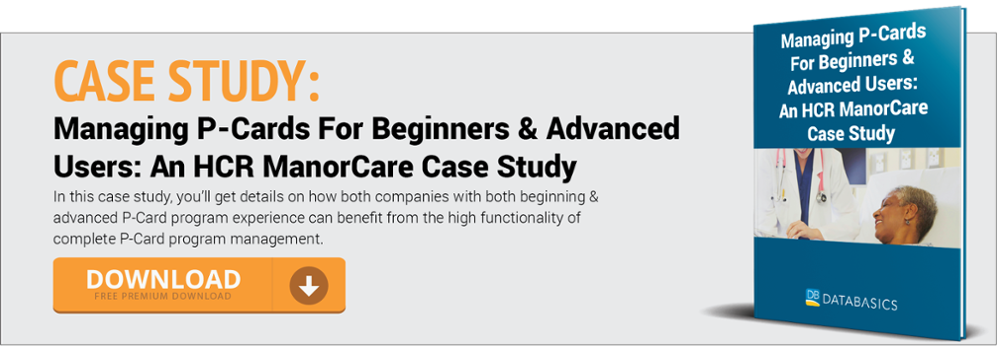
Purchasing Or Procurement Card Best Practices: A P-Card Introduction
Whether you call them P-Cards, PCards, or P Cards (short for “purchasing cards” or "procurement cards"), these business tools are a long-standing method of payment for many institutions. In fact, a 2016 study on P-Card trends by the NAPCP (National Association of Purchasing Card Professionals) shows that of those companies that use P-Cards, only 9% of P-Card programs have been established in the last 5 years or earlier, while 90% had been established for 5 years or longer. That means that lots of companies use them and have used them for a while, so they know generally what P-Cards are used for and the benefits of P-Cards vs. credit cards.
Now that P-Cards are so common, it’s good to know whether you’re getting all that you can out of them and that you’re taking steps to avoid future issues. Get details in this list of P-Card policy best practices:
-
Train employees well. Then keep training them.
Most organizations take the time to teach employees the P-Card policies and procedures that come with using one.
However, one Purchasing Card best practice is to think about training a second time. That way, you can ensure that P-Cards aren’t being used for non-business related P-Card abuse/misuse (like flowers or dance lessons, no matter how romantic it seems). This helps to avoid P-Card fraud and disputes. Plus, you can discuss the importance of hanging on tightly to that P-Card to avoid problems with lost cards.
-
Take control.
After all, control is a major benefit of implementing P-Card program management. Setting limits on cardholders in terms of monthly spend or on the kind of purchase they can make (by blocking particular merchant category codes) will also do some of the heavy lifting for you in terms of manually scanning for violations. Having a P-Card accounting process in place will assist when it comes time for the P-Card audit.
The NAPCP has clear recommendations for controls in the NAPCP's Guide To Establishing and Managing A Program. Notable controls include:
"Determination of specific risks" to lead to "the development, implementation and documentation of controls serving to mitigate those risks.""Completion of a risk analysis" to "aid the intial design of the control environment, as well as provide a way in which controls can be reviewed on an ongoing basis."
Essentially, planning from the start on a specific control environment will assist to clear up the possibility of problems in the future.
-
Have a fair, but clear policy.
Taking the time to make it possible for cardholders to ask questions and bring up concerns means that they will feel more trusted and that they will communicate in the future should a problem arise. For example, having an open-door policy combined with a system of warnings should mistakes occur makes it so that employees aren’t afraid to use their p-cards appropriately. After all, the point of having a p-card program is to use it to take advantage of all the benefits P-Cards bring.
-
Audit. Audit. Audit.
Create rules for certain kinds of transactions that take place at odd hours or that have a shipping address to a place other than the place of business. This is on top of audits for compliance with relevant regulatory agencies within the industry. In other words, use all audit functionality and if you don’t know all that it can do, reach out to the card issuer for help.
-
Have a trusted P-Card management partner.
Speaking of asking for help, develop your relationship with the card issuer. You may find, however, that the card issuer has other priorities or that it doesn’t allow the functionality and control that you need, which is why we recommend that you look into partnering with an established P-Card program manager.
-
Use receipt management software.
Receipt management can be one of the biggest challenges associated with expense reporting. Having a receipt management process in place makes it less likely that P-Card users will misplace receipts. Because they can use the device already in their pocket to file their reports, there are no more excuses. An app with OCR is ideal because receipts can be digitally read and auto-populated within the expense report, reducing the manual workload from the user.
Using these best practices will open up the effectiveness of your P-Card program. After all, more than 50% of organizations that use p-cards are using them to purchase between $1 million-$20 million. And 70% of users are capturing receipts manually, which to us sounds like a lot of time wasted on manual data entry.
Maybe it’s time to upgrade your program.
For more information on the DATABASICS P-Card Program Management solutions, contact us, or call (800) 599-0434.
DATABASICS provides cloud-based, next generation Expense Reporting, P-Card Management, Timesheet & Leave Management, and Invoice Processing automation. Specializing in meeting the most rigorous requirements, DATABASICS offers the highest level of service to its customers around the world.
DATABASICS is relied upon by leading organizations representing all the major sectors of the global economy: financial services, healthcare, manufacturing, research, retail, engineering, non-profits/NGOs, technology, federal contractors, and other sectors.
Connect with DATABASICS: LinkedIn, Twitter, and YouTube. DATABASICS is headquartered in Reston, VA.
Subscribe to our blog
Recent Posts
Posts by Topics
- Expense Management Software (126)
- DATABASICS (69)
- Time Tracking Software (46)
- Leave Management System (26)
- P-Cards (9)
- Home Healthcare (8)
- Government Contractors (7)
- Nonprofit Organizations (7)
- International Development (6)
- Receipt Management (6)
- Advanced OCR (2)
- CROs (2)
- Staffing Agencies (2)
- Vendor Invoice Management (2)
- Audit Management Software (1)
- Construction (1)
- Field Service Management (1)
- Integration (1)
- Microsoft Dynamics (1)
- Oracle NetSuite (1)
- Partnerships (1)
- Professional Services (1)
Read on

Buyer’s Guide to Timesheet & Expense Reporting Software
Read Now
DATABASICS In Review: 2025's Top Innovations & Most Popular Content
Read Now
Time & Expense Year-End Preparation & New Year Kickoff To-Do List
Read Now
Combating AI-Generated Receipt Fraud with Spend Control
Read NowIRS Mileage Rate 2026 Predictions: Trends, History, EV Costs, and How Companies...
Read Now
DATABASICS Wins Silver In Best In Biz Awards 2025: Celebrating Excellence In...
Read Now
Subscribe to Our Blog
Subscribe to our blog and get the latest in time tracking and expense reporting news and updates.
